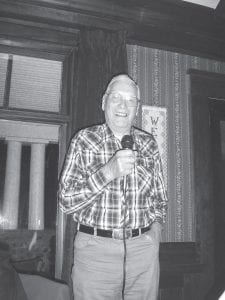Walter Sve, a lifelong Lake Superior fisherman, was the keynote speaker for the Cook County Historical Society’s 86th annual dinner. A resident of Lake County, Sve was born near Split Rock Lighthouse to Norwegian immigrants Ragnvald and Ragnhild Sve. The family made its living netting herring in Lake Superior. They also built and sold fish boxes to other fishermen and, later, when more and more tourists came to the Northland, built and rented cabins to them, 10 in all. Their business became known as Split Rock Cabins.
But to get started, Walter’s father purchased 54 acres of property from a logging company. Some of the land was on the shore and there he built a 14-by-18-foot fish house with an upstairs that he and his wife lived in. It was supposed to be a temporary house. But the Depression came and by 1936, when a larger house was finally erected, the couple had four children living in the crowded quarters. And downstairs—the fish house where Ragnvald processed fish—was so small he couldn’t stand up straight in it.
So times were tough. But the fishermen were close and the family closer.
No one had much money. Especially fishermen. Back then, herring, the main catch, paid as little as two cents a pound, said Walter.
At 16, Walter began fishing with his father. He also served as a charter boat captain for the family, taking trout fishermen out onto the big lake until 1955, when the lamprey had effectively wiped out most of the trout. Charter boat fishing was all but gone, at least for the next 20 years.
When Reserve Mining in Silver Bay began dumping tailings into the lake in 1955 the water became “very murky,” said Sve, and commercial fishermen had to go out as far as seven miles to net herring. “Herring don’t like dirty water,” noted Sve.
In 1980, Reserve Mining, having lost its case to continue dumping tailings into Lake Superior, began pumping its taconite tailings into a waste pond. Sve’s testimony against the mining giant was one of the reasons the mine had to move its dumping ground from the lake inland.
It was 25 years before Walter and the other fishermen took herring close to Silver Bay again.
Like a lot of fishermen, Walter worked a second job. He was employed at the DM&IR railroad in Two Harbors, working the second shift so he could fish. In 1961, after the railroad shut down, Walter became a carpenter. He rented cabins and when the herring returned in the early 1990s, he returned to casting herring nets in the lake, this time with his son Eric.
Sve recounted numerous epic storms, losing nets and finding them many miles away, repairing nets, losing fellow fishermen to the big lake, the trouble with lamprey and the continued struggle with maintaining a commercial fishing operation. It is a tough life, but a life Sve has loved and recounted in great detail. Today, both Walter and his son Eric continue to fish.



Loading Comments